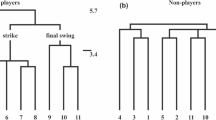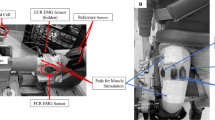Summary
The aim of this study was to investigate the electromyographical basis of inaccurate movement by identifying the variate and invariate characteristics of a ballistic, isometric precision-grip skill.
Our results have shown that in most subjects investigated, IEMG, discharge rate and the paterns of muscle synergy were variate movement parameters while the sequence of muscle activation, the relative duration of muscle activity and the time to peak force (rise-time) remained essentially invariante.
Based on these results, we can conclude that inaccurate performance of this skill, in most of the subjects investigated, was more dependant upon changes in muscle IEMG than in alterations in the temporal sequencing of muscle activity. It was apparent that from trial to trial, subjects had more difficulty in reproducing the appropriate levels of muscle contraction and synergy than in reproducing the required periods of action.
Similar content being viewed by others
Abbreviations
- FON:
-
Onset of force (ms)
- FP:
-
Time of peak force (ms)
- TP:
-
Time to peak force (rise-time) (ms)
- MVC:
-
Maximum voluntary contraction
- ON:
-
Onset of muscle activity (ms)
- DUR:
-
Duration of muscle activity (ms)
- FPK:
-
Magnitude of maximum force (% of MVC)
- FI:
-
Force integral (% of MVC·ms)
- IEMG:
-
Integrated electromyogram (mV·ms)
- DR:
-
Discharge rate (mV·ms/ms)
- DI:
-
First Dorsal Interosseus
- AP:
-
Adductor Pollicis
- AbP:
-
Abductor Pollicis Brevis
- LF:
-
Long flexors
- ED:
-
Extensor Digitorum
References
Angel RW (1977) Antagonist muscle activity during arm movements: central versus proprioceptive influences. J Neurol Neurosurg Psychiat 40: 683–686
Benecke R, Meinck H-M, Conrad B (1985) Rapid goal-directed elbow flexion movements: limitations of the speed control system due to neural constraints. Exp Brain Res 59: 470–477
Bossom J (1974) Movement without proprioception. Brain Res. Amsterdam 71: 285–296
Brown SHC, Cooke JD (1981) Amplitude and instruction dependant modulation of movement related electromyogram activity in humans. J Physiol (Lond) 316: 97–107
Carter MC, Shapiro DC (1984) Control of sequential movements: evidence for generalised motor programs. J Neurophysiol 52: 787–796
Chernikoff R, Taylor FV (1952) Reaction time to a kinesthetic stimulation resulting from sudden arm displacement. J Exp Psychol 43: 1–8
Fitts PM (1964) Perceptual motor learning. In: A. W. Melton (Ed) Categories of human learning. Academic Press, New York
Freund HJ, Budingen HJ (1978) The relationship between speed and amplitude of the fastest voluntary contractions of human arm muscles. Exp Brain Res 31: 1–12
Henry FM (1960) Increased response latency for complicated movements and a “memory drum” theory of neuromotor reaction. Res Quart 30: 448–459
Henry FM, Rogers DE (1960) Increased response latency for complicated motor reaction. Res Quart 31: 448–458
Inman VT, Ralston HJ, Saunders JBCM, Feinstein B, Wright EW Jr (1952) Relation of human electromyogram to muscular tension. Electroenceph clin Neurophysiol 4: 187–194
Jackson KM (1982) Digital analysis of electromyograms — A fortran package. Electromyo Clin Neurosci 22: 65–87
Keele SW (1968) Movement control in skilled motor performances. Psych Bull 70: 387–403
Keele SW, Manchester DL, Rafal RD (1985) Is the Cerebellum involved in motor and perceptual timing: A case study. Technical report 85-4, Cognitive science program, University of Oregon
Keele SW, Posener MI (1968) Processing of visual feedback in rapid movements. J Exp Psychol 77: 155–158
Lashley KS (1917) The accuracy of movement in the absence of excitation from the moving organ. Am J Physiol 43: 169–194
Lippold OCJ (1952) The relation between integrated action potentials in a human muscle and its isometric tension. J Physiol (Lond) 117: 492–499
Pew RW (1974) Acquisition of heirarchial control over the temporal organisation of a skill. J Exp Psychol 71: 764–771
Polit A, Bizzi E (1979) Characteristics of motor programs underlying arm movements in monkeys. J Neurophysiol 42: 183–194
Rosenbaum DA, Saltzman E (1984) A motor-program editor. In: Prinz W, Sanders AF (Ed) Cognition and motor processes. Springer, New York, pp 51–61
Rothwell JC, Traub MM, Day BL, Obeso JA, Thomas PK, Marsden CD (1982) Manual motor performance in a deafferentated man. Brain 105: 515–542
Schmidt RA (1975) A schema theory of discrete motor skill learning. Psychol Rev 82: 225–260
Schmidt RA (1979) Motor-output variability: A theory for the accuracy of rapid motor acts. Psychol Rev 86: 415–451
Schmidt RA (1982) Motor control and learning: a behavioral emphasis. Human Kinetics, Champaign, IL
Sirin AV, Patla AE (1987) Myoelectric changes in the triceps surae muscles under sustained contractions: Evidence for synergism. Eur J Appl Physiol 56: 238–244
Taub E, Berman AJ (1968) Movement and learning in the absence of sensory feedback. In: Freedman SJ (Ed) The neuropsychology of spatially orientated behaviour. Dorsey Press, Homewood, Ill.
Wallace SA, Wright L (1982) Distance and movement time effects on the timing of agonist and antagonist muscles: A test of the impulse-timing theory. J Mot Beh 14: 341–352
Woodworth RS (1899) The accuracy of voluntary movement. MacMillan, New York
Yoneda T, Oishi K, Ishida A (1983) Variation of amount of muscle discharges during ballistic isometric voluntary contraction in man. Brain Res 275: 305–309
Author information
Authors and Affiliations
Rights and permissions
About this article
Cite this article
Brown, J.M.M., Bronks, R. The electromyographical basis of inaccurate motor performance. Europ. J. Appl. Physiol. 58, 132–140 (1988). https://doi.org/10.1007/BF00636616
Accepted:
Issue Date:
DOI: https://doi.org/10.1007/BF00636616




